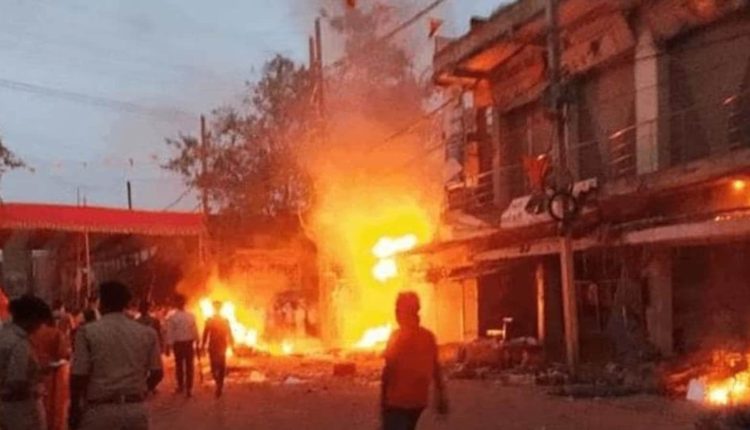PATNA: In March 2018, Bihar and neighbouring West Bengal witnessed communal clashes for several days following the day of Ram Navami. Though it was limited to the Asansol-Raniganj area in West Bengal, the violence spread to at least eight districts in Bihar.
The clashes which began between two communities over a procession route at Nathnagar in Bhagalpur on March 17, 2018 spread to Siwan, Aurangabad, Samastipur, Munger, Nalanda, Sheikhpura and Nawada by March 30, prompting the authorities to deploy additional policemen and paramilitary troopers to control the situation. More than 100 people, including policemen, were injured in the violence and several shops and business establishments were set on fire.
On March 30, clashes broke out again on Ram Navami. This time, two districts, Rohtas and Nalanda were badly affected while four others, Gaya, Bhagalpur, Muzaffarpur and Munger, were partially affected. At least 200 people were arrested in the violence that broke out in Rohtas and Nalanda, where houses were attacked, shops, mosques and vehicles set on fire, leaving two dead and at least 25 injured.
Bihar has its own communal past. The state has seen some of the worst communal clashes during India’s partition soon after Independence.
History of riots in Bihar
Historians, however, trace the history of riots from before the British left India. “In 1917 there was a riot in Sasaram also called Shahabad riots as well as the Bakr-Eid riots as the issue fanning the clash was cow deaths. The riots proved to be the first major challenge for Mahatma Gandhi whose non-cooperation movement saw a major fault line – between Hindus and Muslims – and it contradicted his methodology of satyagraha,” said Professor Ashok Aounshuman, department of history, L S College, Muzaffarpur.
What is remarkable about the series of incidents in 1917 is their extended character, involving most of the region between Arrah and Aurangabad, on both sides of the Sone river. Crowds of 20,000 to 50,000 participants reportedly attacked the villages.
The state has, since then, witnessed sporadic clashes mostly over cow deaths. The riots in Bihar were confined mostly to the southern part of the state, with the Ganges river in the middle. “The riots were confined to south districts like Gaya, Shahabad, Patna, etc. The north saw relatively less skirmishes,” said Aounshuman. South Bihar has dense pockets of Muslim population.
As Bihar shared its boundary with then undivided Bengal, the effect of communal clashes spilled over. The next big incident was reported in 1946. The riots, which took place between October 24 and November 11, were triggered by the Great Calcutta killings, as well as the Noakhali riots. Gandhi declared that he would fast unto death if the riots did not stop.
Post-independence, the state saw some major riots. The silk city of Bhagalpur witnessed one of the worst riots in 1989 in which more than 1,000 people were killed. The Justice NN Singh Inquiry Commission report formed to look into its causes was tabled in the Bihar assembly in 2015. Inaction by the then Congress government led by Satyendra Narayan Sinha was found to be responsible for the deadly clashes. The 1,000-page report also raised a question about the state police administration hinting towards a communal bias. More than 50,000 people were displaced as a result of the riots which started on 24 October 1989, and continued for the next two months. The violence affected Bhagalpur city and 250 villages around it.
A period of peace
With the change in the dispensation in the 1990s and Lalu Prasad becoming chief minister, Bihar saw an emergence of new social engineering as backward classes now allied with Muslims in Bihar. This was the genesis of the M-Y-D (Muslim, Yadav, Dalit) combination of the Lalu-led Rashtriya Janata Dal (RJD). This new socio-political coalition ensured that communal violence was dispensed with.
In 2005, when Nitish Kumar took over with the support of the Bharatiya Janata Party (BJP), he followed a similar path in an effort to win over the RJD’s Muslim support base.
“When Lalu Prasad stopped L K Advani’s rath yatra [to drum up support for the Ram Temple issue] in Bihar in 1990, and had him arrested, Bihar didn’t report communal clashes. It’s the same with the administration under Nitish Kumar. The RJD or the JD (U) ensured that the state’s communal harmony is not disturbed even though they may have faltered on other parameters,” said Gyanendra Yadav, associate professor of Sociology, College of Commerce, Patna.
The best administrative rule may not be able to stop violence, but a communal riot can only be allowed to continue with administrative complicity. “Many incidents of communal violence happen with the complacency, even complicity of the local administration. How can one not take precaution despite alerts and intelligence inputs,” he asked.
Nevertheless, Bihar saw a few incidents of communal violence between 2012 and 2017, data collected through the responses of union ministers Kiren Rijiju and Hansraj Ahir in Lok Sabha in 2016 and 2018 respectively, shows. Among the north Indian states, Bihar reported 366 such incidents in this period, Uttar Pradesh reported the highest number of cases at 1,010, Madhya Pradesh had 441, and Rajasthan, 380. Other large states such as West Bengal reported 180 incidents and Jharkhand 85 (data of Jharkhand for 2017 wasn’t available).
The fatality in such cases during this time was the highest in UP at 237, Madhya Pradesh had 53, Bihar 42, Rajasthan 32 and Jharkhand 12.
“Riots don’t happen, they are created,” said retired professor of History O P Jaiswal, Patna University, who was also a member of the Indian Council of Historical Research.


